Ragda is a curry or gravy preparation made from dried white peas, spices and seasonings. It is used in making various chaat snacks like Pani Puri, Ragda Puri, Ragda Patties or Ragda Chaat or Masala Puri. But it is also delicious to eat these white peas curry with dinner rolls (pav) or bread or with a topping of crunchy onions, chutneys, chaat masala, lemon juice or yogurt and sev.
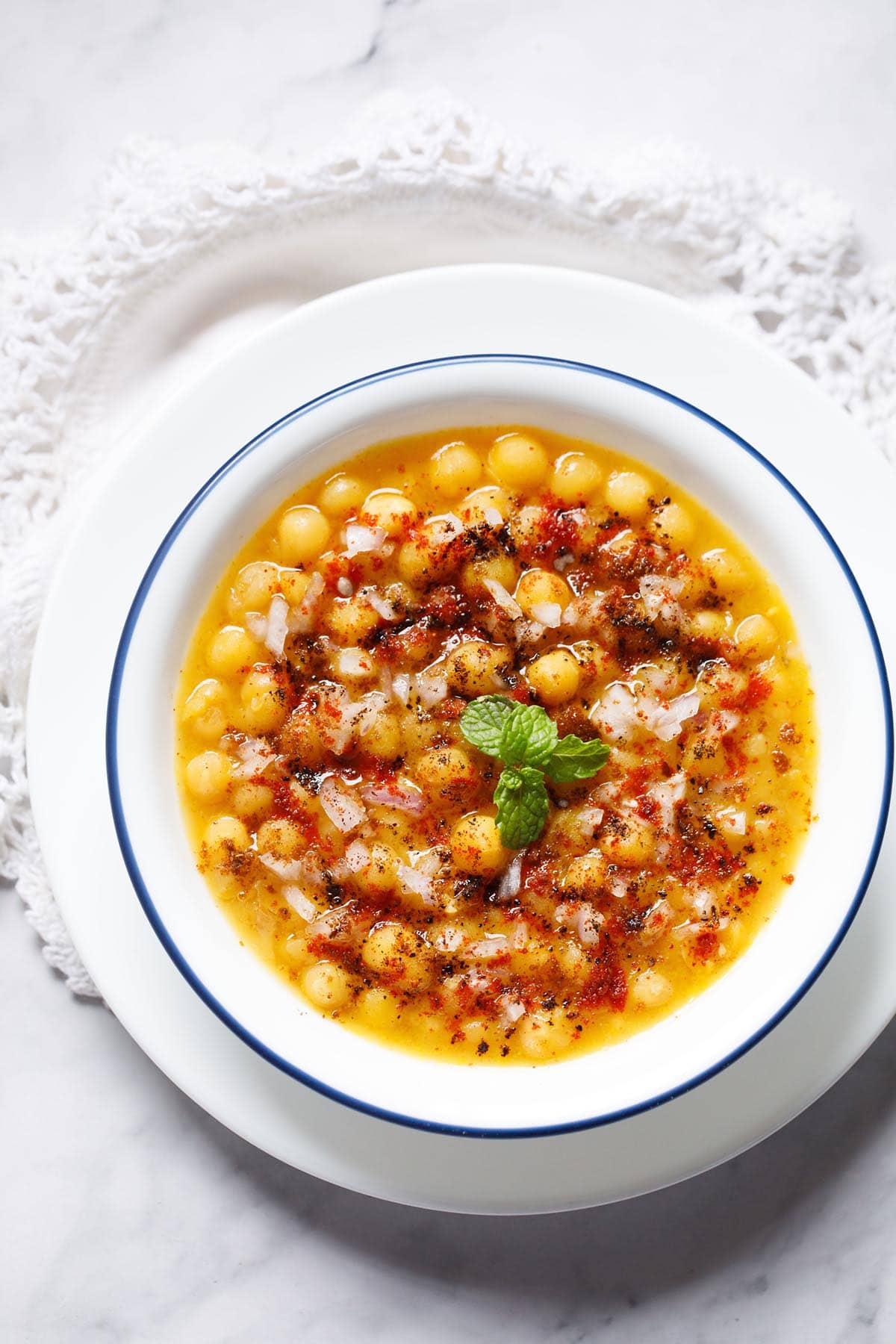
About This Ragda Recipe
I share a ragda recipe that I have been making for years having learned it from my mom. This recipe uses minimal seasonings so that the flavors of the white peas shine through.
Moreover this simple white peas curry balances the flavors and is in harmony with the chutneys when you make any chaat items with it.
It is always better to have a minimally seasoned ragda curry rather than going overboard with a lot of ingredients added to it. Especially when you are going to use this ragda curry for making many chaat snacks.
Even this minimally spiced ragda gravy tastes great when topped with some onions, tomatoes, chaat masala and lemon juice.
While making pani puri, I prefer to make ragda instead of boiled sprouted moong and potatoes. Just a personal liking. The process of making ragda is simple but takes a little long time as you need to soak the dried white peas.
In Mumbai, ragda is used instead of Chole or Chana Masala with the Aloo Tikki – making it ragda patties. It is a famous dish and one of our favorite chaat.
Ragda is also used in pani puri instead of boiled chickpeas, moong and potatoes. Dried white peas are also used to make Masala Puri chaat which is a famous chaat snack from Bangalore city.
You can make ragda with dried green peas too. Dried green peas are also used in making Matar Kulcha.
How to make Ragda Recipe
Soak Dried White Peas
1. Pick and rinse 1 cup of white peas for a few times in fresh water. These peas are slightly creamish or creamish yellow in color.
Soak the white peas overnight in enough water. Remember to add triple the amount of water so that they get soaked properly.
The next day, you will see beautiful smooth rounded creamish yellow colored peas almost doubled in size.
Drain the water. Rinse the soaked peas in fresh clean water a couple of times and drain all the water.
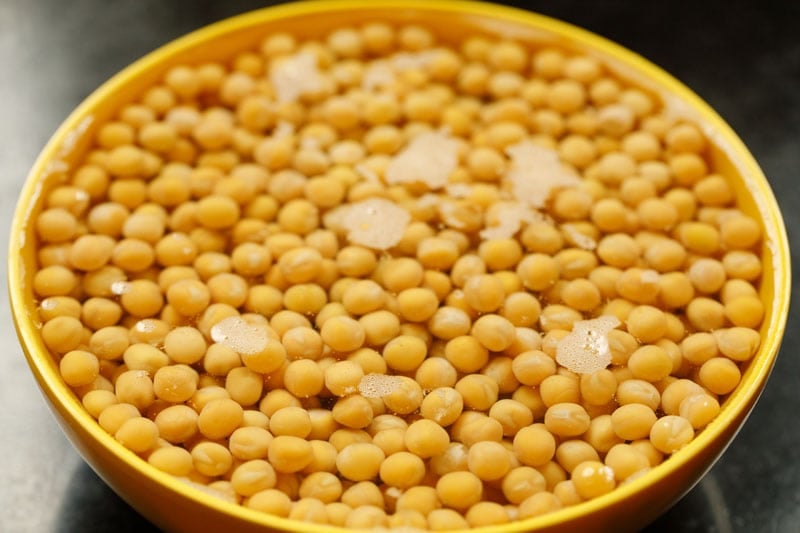
2. You can also use dried green peas. Soak them overnight as you do for white peas. Drain the water and set it aside.
I have made ragda many times with dried green peas and they also taste good.
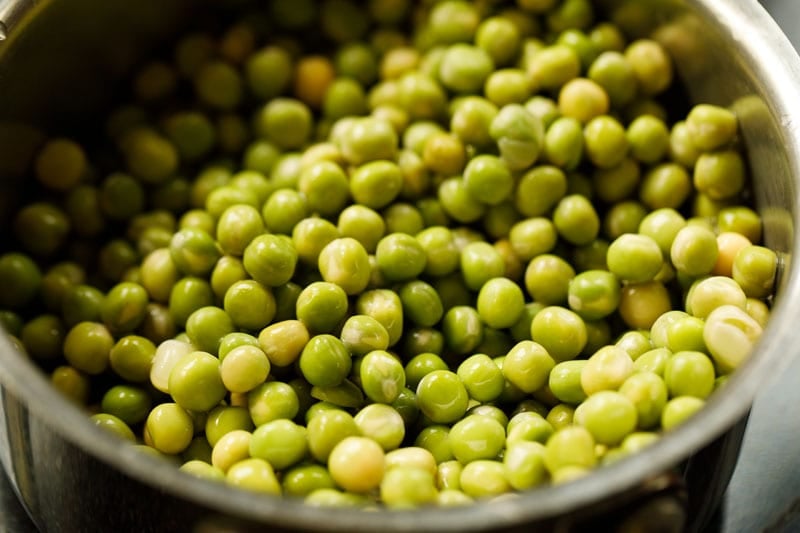
Cook Dried Peas
3. Now you have the option of cooking the soaked peas in an Instant top or a stove-top pressure cooker. I would not recommend cooking these in a pan as it will take a lot of time – possibly an hour or more.
In the stepwise photos below, I show the method of cooking dried white peas in an Instant pot. But I have also listed on how to cook these peas in a stovetop pressure cooker.
- Instant Pot Method: Add the soaked white peas together with ¼ teaspoon turmeric powder, ½ teaspoon red chilli powder, 1 pinch of asafetida (hing) and salt as required. Also add 1 tablespoon oil.
- Stovetop Pressure Cooker Method: In a 3 litre stovetop pressure cooker, add the soaked white peas with ¼ teaspoon turmeric powder, ½ teaspoon red chilli powder, 1 pinch of asafetida, salt as required and 1 tablespoon oil. Add 2.5 cups of water and mix well.
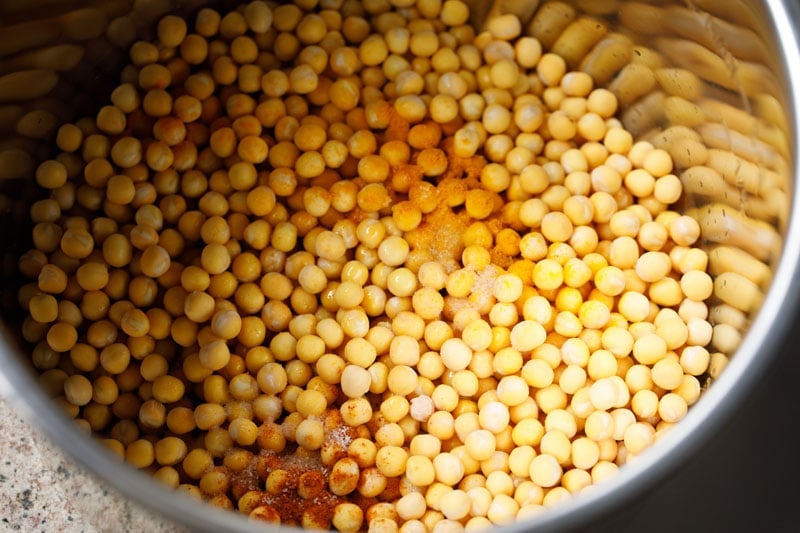
4. Add 2 cups of water to the Instant Pot. Mix with a spoon.
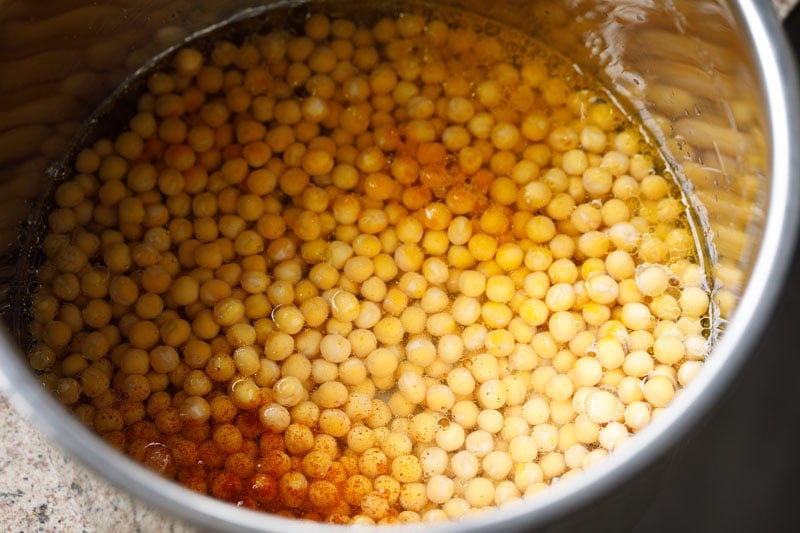
5. When I make ragda patties or pani puri, I prefer to cook the peas and potatoes together in the Instant pot or pressure cooker to save time. Showing the method here in this step. But this is optional.
To do this, place a trivet in the Instant Pot or the stove-top pressure cooker. Place rinsed potatoes in a steel bowl or pan. Place this bowl or pan with the potatoes on the trivet.
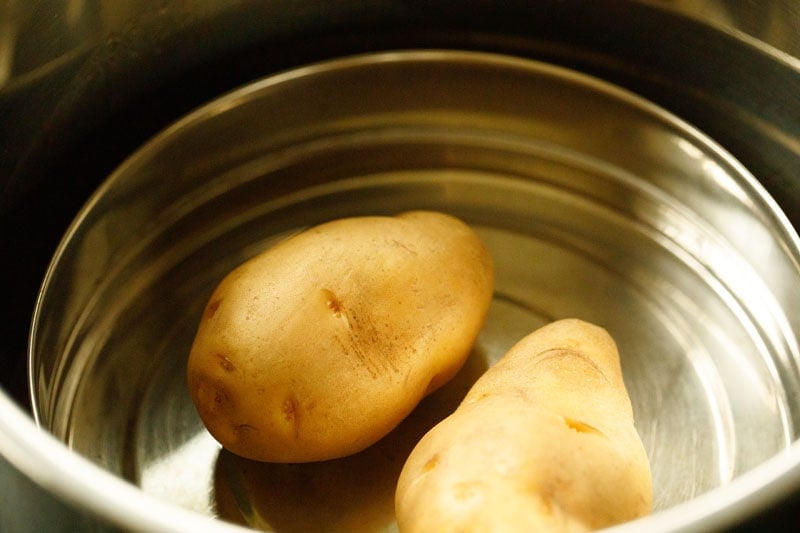
6. Pressure cooking.
- For pressure cooking in Instant Pot: Seal with the instant pot lid with the pressure valve positioned in the sealing mode. Pressure cook for 30 minutes on high pressure.
- For stovetop pressure cooking: Pressure cook for 15 to 20 minutes on medium heat.
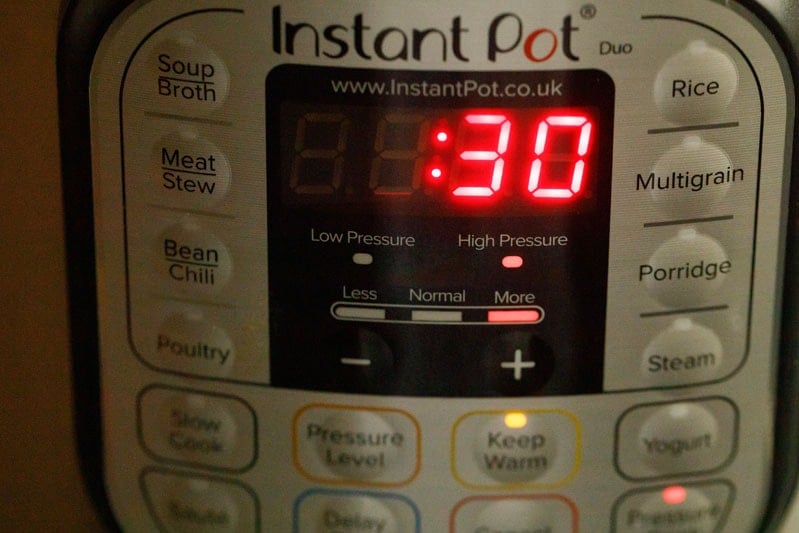
7. Checking the doneness of the potatoes and white peas after cooking.
- Instant Pot: After pressure cooking for 30 minutes the Instant pot will beep. Allow the pressure to release naturally for 10 minutes and then lift and release the valve. Open the instant pot lid. Check the potatoes with a fork or knife. The fork should pass easily through the potatoes.
- Stove-top cooker: When the pressure falls down on its own in the cooker, then only open the lid and check to see if the potatoes and peas are cooked. These peas take a long time to cook.
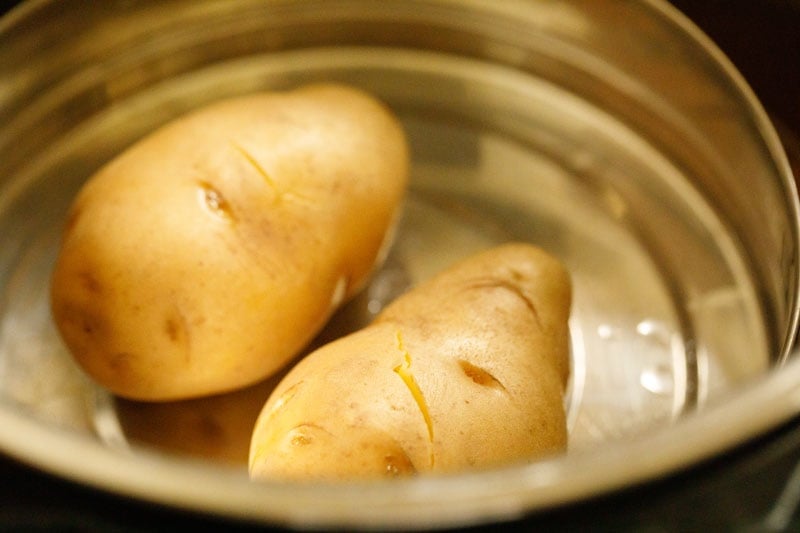
8. Check the cooked peas. Generally, it happens that some of the peas get cooked thoroughly, whereas a few remain partially cooked. If this is the case you will have to cook them for some more minutes.
- Instant Pot: If they are undercooked or have a bite in the center, then pressure cook again for 10 minutes more on high pressure setting.
- Stove-top Pressure cooker: Pressure cook on medium heat for 8 to 10 minutes if the peas are undercooked. Add 1 cup water or as required if needed while pressure cooking on the stove-top for the second time.
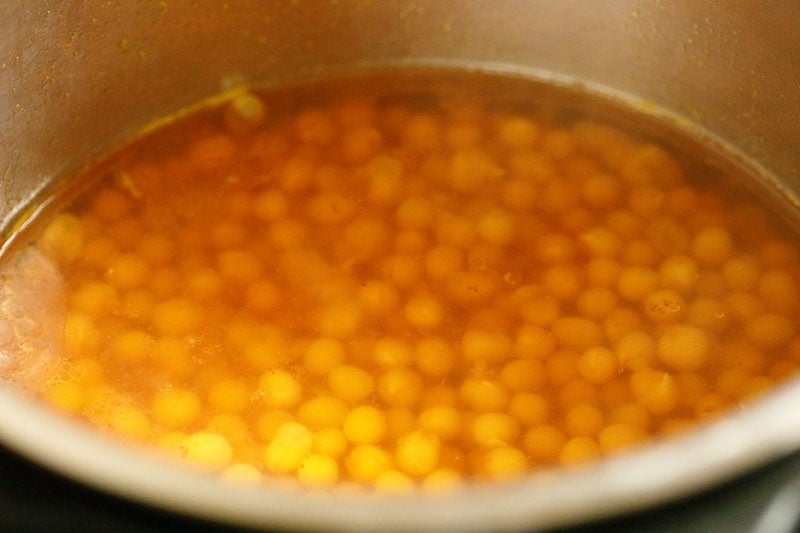
Make Ragda
9. Once the peas have become soft and mushy, check for the consistency of the ragda.
- For the Instant Pot: Now with a vegetable masher or potato masher, begin to mash some of the cooked peas. Mashing the cooked peas thickens the ragda.
- For stove-top pressure cooker: If it is slightly watery, then evaporate the water by cooking the ragda in the stovetop pressure cooker without the lid. Mash some cooked peas with a potato masher. The ragda should not be very thick nor watery. Just slightly thick.
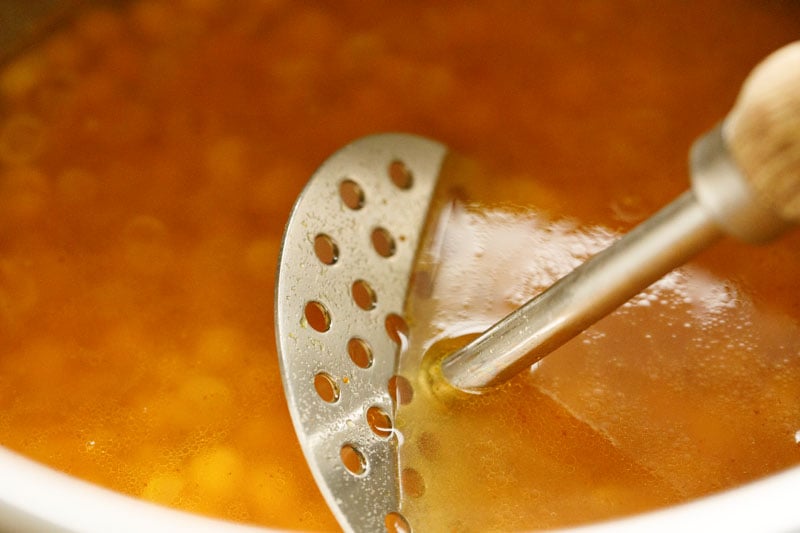
10. Cooking and simmering further.
- Instant Pot: Press the sauté button, and set the time for 10 to 12 minutes. Using the “saute” option cook for about 10 to 12 minutes or more until the consistency of the gravy thickens. Remember you should not see thin or watery consistency. Ragda has medium to medium-thick and flowing consistency. Add a bit of hot water and mix if in case the consistency looks very thick. Switch off the instant pot.
- Stove-top pressure cooker: Simmer on low to medium-low heat without lid until the consistency becomes medium to medium thick. Keep stirring often. Switch off the heat.
Once you get the desired consistency, check the seasonings and adjust accordingly by adding more red chilli powder or salt.
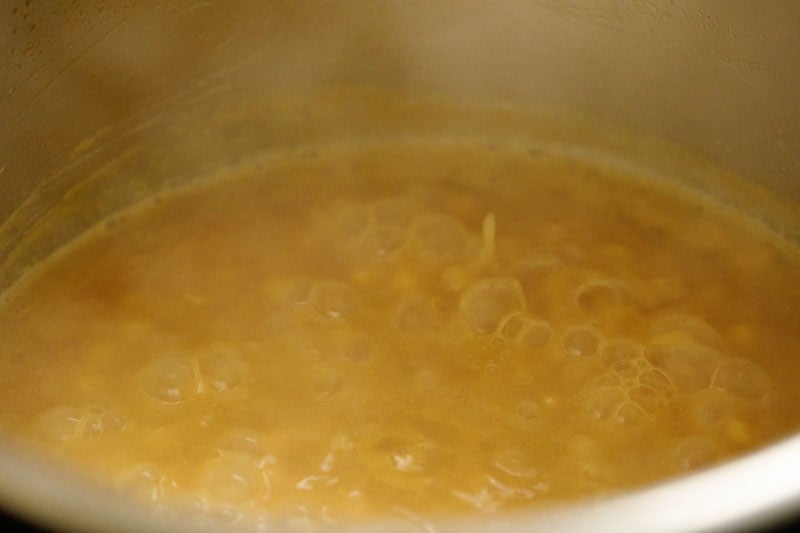
What to make with Ragda
Now this ragda can be used as the filling for Pani Puri. It can also be used to make Ragda Pattice or a Ragda Chaat.
To enjoy it in a simple way, take the piping hot ragda in a bowl. Add some finely chopped onions.
Sprinkle with a few pinches of roasted cumin powder, black salt or regular salt and chaat masala powder. Drizzle some lemon juice and garnish with coriander leaves or mint leaves.
Additionally, you can sprinkle some sev or crushed papdi or golgappa puri. Enjoy!
Note that on cooling the consistency will thicken more. To thin out the consistency a bit, add some water and reheat it until warm or lightly hot.
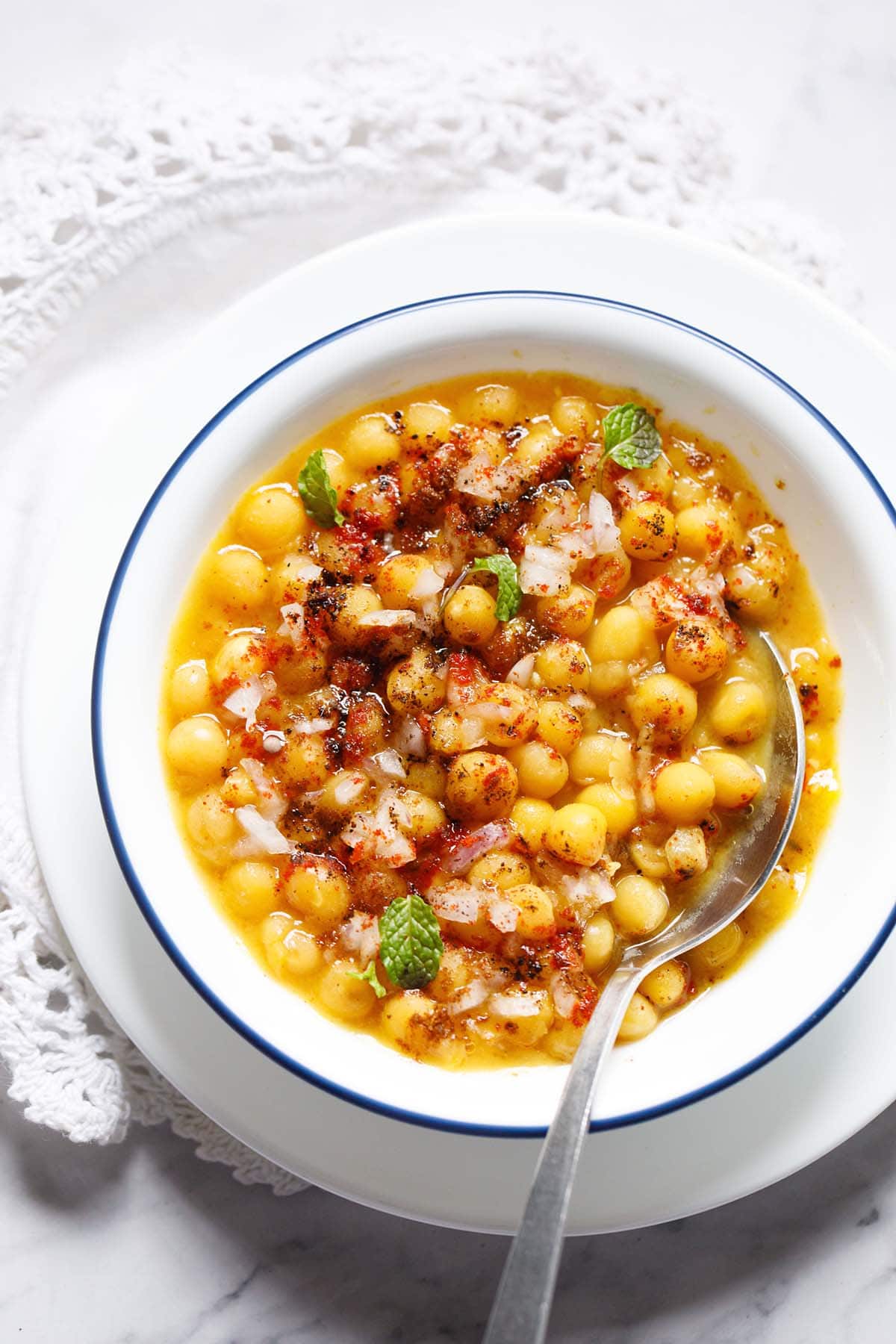
More Tasty Snacks recipes
If you’ve tried this recipe, please rate it in the recipe card or leave a comment below – I’d love to hear your feedback. For more vegetarian inspiration, sign up for my email updates or follow me on Instagram, Youtube, Facebook, Pinterest or X.
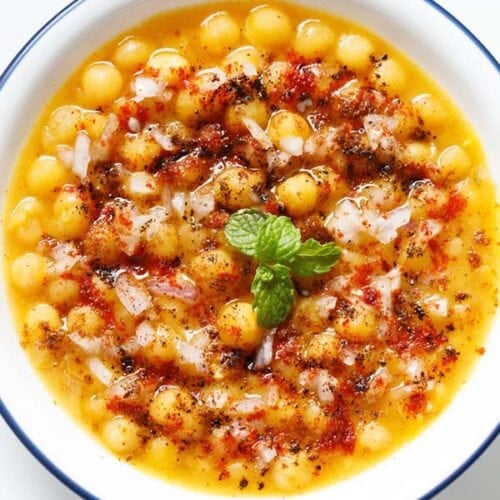
Ragda Recipe (Simple & Easy)
Ingredients
- 1 cup dried white peas (safed matar or safed vatana) or dried green peas
- ¼ teaspoon turmeric powder (ground turmeric)
- ½ teaspoon Red Chili Powder or cayenne pepper
- 1 tablespoon oil
- 1 pinch asafoetida (hing)
- 2 cups water for Instant Pot and 2.5 to 3.5 cups water for stovetop pressure cooker
- salt as required
Instructions
Soaking dried white peas
- Start the night before. Pick and rinse the dried white peas a few times in water.
- Soak the peas overnight or for 8 to 9 hours in triple the amount of water.
- Drain the water. Rinse the white peas in fresh clean water a couple of times and then drain the water.
Cooking Ragda in Instant Pot
- Take the peas, turmeric powder, red chilli powder, salt and oil in the steel insert of the instant pot. Add 2 cups water.
- Secure and seal with the instant pot lid. Move the valve and secure or keep it at the sealing position.
- Press the pressure cooking/manual switch and set the time to 30 minutes selecting high pressure.
- Pressure cook for 30 minutes. When you hear the beep sound after the pressure cooking is complete, then wait for 10 to 12 minutes before lifting the valve to release any pressure.
- Check to see if the cooked peas are softened. If they are undercooked or have a bite in the center, pressure cook again for 10 minutes on high pressure.
- When the peas have thoroughly cooked and softened, check the consistency. If its runny or watery, then the ragda needs to be cooked more to get the curry to the desired consistency.
- Mash some of the peas with a potato masher. This helps to thicken the consistency.
- Press the 'sauté' switch on the instant pot and set time to 10 to 12 minutes. Simmer the curry until it gets a medium to medium-thick consistency. Stir often.
- Check the taste and add more salt or red chilli powder if required.
- When the ragda has the desired consistency, then switch off the Instant pot. You can now serve it hot or warm.
Making Ragda in stove-top pressure cooker
- In a 3 litre pressure cooker, add the soaked white peas with the turmeric powder, red chilli powder, asafoetida, oil and salt.
- Add 2.5 cups water and mix well. Pressure cook for 15 to 20 minutes on medium heat.
- When the pressure falls in the cooker on its own, then only open the lid and check to see if the peas are tender and softened.
- These peas take a long time to cook. If they are not cooked completely, pressure cook again for 8 to 10 minutes. Add 1 cup water or as required if needed and pressure cook on medium heat the second time.
- Once the peas have become soft and mushy, check for the consistency of the ragda.
- If it is slightly watery, then evaporate the water by cooking the ragda in the pressure cooker without the lid. Stir often.
- The ragda should not be very thick nor watery. Just slightly thick with a medium to medium-thick consistency.
- Check the seasonings and adjust accordingly by adding more salt or red chilli powder.
- Now this ragda can be used as the stuffing for pani puri or to make any chaat snack like ragda pattice or ragda puri.
- For a simple snack, pour the hot ragda in a bowl. Top it with some finely chopped onions, few pinches of roasted cumin powder, chaat masala, black salt or regular salt. Drizzle some lemon or lime juice and garnish with coriander leaves or mint leaves.
- You can also add a light sprinkle of some sev (fried gram flour vermicelli) or crushed papdi or crispy golgappa puri.
Notes
- Use the dried white peas that are in their shelf life. The aged or older white peas will take a lot of time to cook.
- For a gluten-free ragda recipe, skip adding the asafoetida or source gluten-free asafoetida.
- Make sure that the dried peas are cooked and softened completely. They should not have any bite in the center. Undercooked peas will digestion problems.
- It is important to soak the dried peas at least for 8 to 9 hours or overnight in water. Always rinse the peas thoroughly before and after soaking to get rid of phytic acid.
- You can vary the seasonings and spices according to your taste. If you prefer a spicy tasting ragda gravy then add more red chili powder.
- The recipe can be scaled easily to make a big batch.
- The approximate nutrition info is for per serving of ragda made with dried green peas.
Nutrition Info (Approximate Values)
Ragda recipe from the archives was first published on July 2010.
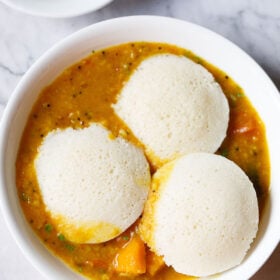
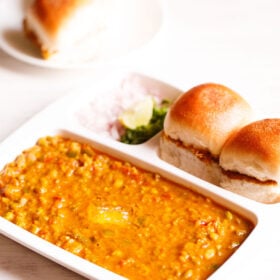
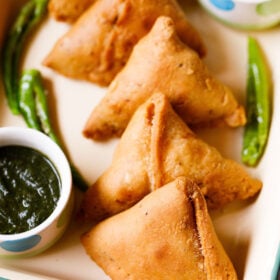
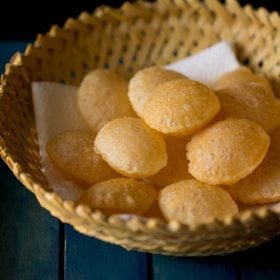









Superb recipes and very well explained. Thanks Ma’am.
Most welcome and thank you.
Exceptional
Your recipes are so well written and easily to follow. The dishes come out perfectly each time! I have been following your recipes for quite some time now (after i chucked out my cook) and gave been very happy with the outcomes! Thanks a lot Dassana!
thank you sapna for this lovely feedback. glad to read it. most welcome and happy cooking.
I always do ur recipes when my hubby wants to eat something like this but made at home.. I made this lots of time and he loves it alot… Thanks for such amazing recipes… Loving all these recipes… Me ND my husband both r diheart fan of Pani Puri and making it at home means delicious treat to me and him also… Thank u very much…
Welcome Seema. Glad to know this. Thanks for sharing this positive feedback. Being from Mumbai I also love pani puri and other chaat snacks like pav bhaji, bhel puri etc.
Hi Dassana, I was missing urban tadkas ragada chat after moving to Tamilnadu. I really loved the chat it was quick and easy. I just made a slight tweek added few garam masala, coriander powder along with chilli powder and jeera powder.
Chat prepared with mint chutney, imly chutney, puri, onion. Tossed with chilli powder, chat and pani puri masala, jeera powder, sev and coriander leaver with a pinch of lemon on ragda. It was awesome, I forgot to take a pic dwelting in it’s deliciousness, definetly will add a pic next time. Thanks…
thanks vijay for sharing all the variations. garam masala, coriander powder, jeera powder can be added. i am sure ragda chaat must have tasted awesome.
Actually i need the street taste of ragada
this is a very simple preparation and one that goes very well with pani puri. usually most street side vendors in mumbai, make the ragda recipe this way. they do not add too much spices. but yes there can be some more variations.
It is not so much clear about the preparation of ragada.